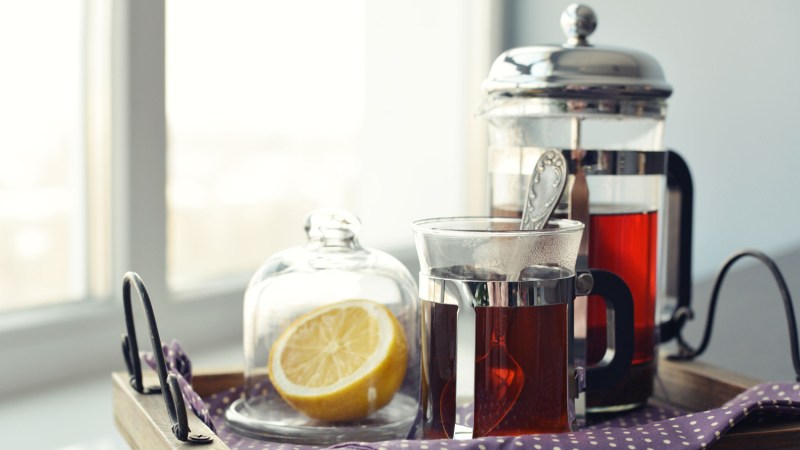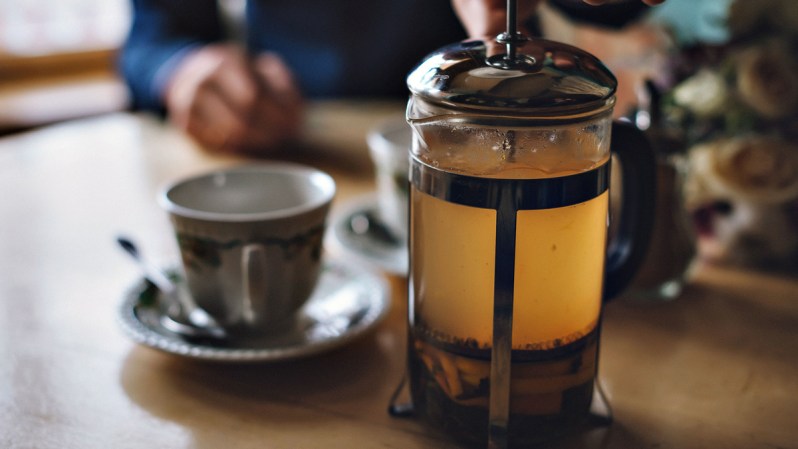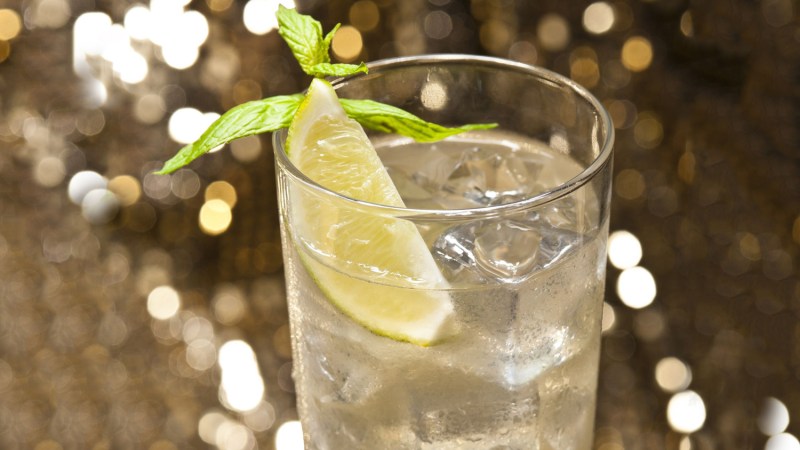
This trend has been percolating for quite some time as seasoned mixologists have developed air-tight methods for creating hot and cold drinks. Hot cocktail lovers can enjoy a simpler technique that yields more complex flavors while cold/room temperature cocktails can get a better infusion process. Either way, you’ll be able to yield multiple drinks, maybe even enough for a dinner party, depending on the size of your press. While some insist on buying a new French press specifically for cocktails, your everyday press will work just fine if you wash it well and regularly.
Hot French Press Cocktails
Say goodbye to boring hot toddies, making drinks directly in mugs, and ill-advised attempts to put hot water in a metal cocktail shaker (it’s okay, we won’t tell anyone). Hot French press cocktails undergo a rapid infusion that you have complete control over.
Kevin Denton, national mixologist for Pernod Ricard, broke down the best way to achieve optimal infusions, according to Food52. You’re going to want to use a brown spirit with roughly a 2:5 ratio to water. You can also work with sweet alcohol like brandy, vermouth, or another fortified wine at a 1:2 ratio to your chosen liquor.
Heat your water and alcohol separately, letting the latter get to about 190° F. Place your infusion ingredients (fruit slices/peels, spices, tea, rose petals, etc.) at the bottom of the press. Add the alcohol first and let it cool to the point where the ethanol doesn’t burn your nostrils. Then, add the water, stir, and steep.

While your cocktail is steeping, don’t forget to prep your glass/mug by warming it with hot water or even by popping it in the microwave. You can steep for the standard four minutes or adjust the time as you get more comfortable with the process/adventurous with your infusions. Plunge and serve immediately for the best result.
Now that you have the basics down, here’s a hot recipe to get you started:
Hot Boulevardier
J. Fergus, The Manual, Los Angeles
- 5 oz water
- 2 oz rye whiskey
- 1 oz sweet red vermouth
- 1 orange
- 1 tsp lemon juice
- 1 tsp tarragon
- 4 dashes Angostura bitters
- 2 rosemary sprigs
Method: Heat whiskey, Campari, and vermouth on medium heat for two minutes. Peel all of the skin off the orange and place into a French press. Add bitters, tarragon, and lemon juice to the press. Stir in heated spirits. Boil water and let cool for one minute. Stir in water. Let mixture steep for seven minutes. Plunge and pour into warmed coupe glass. Garnish with rosemary sprig. Serves 2.
Regular/Cold French Press Cocktails
These cocktails won’t pack as flavorful a punch as their warmer kin, but they definitely offer a new twist on your favorite drinks. Simply add your infusion ingredients to the French press (muddling optional), pour in your alcohol and mixer, stir, and steep. More pungent ingredients work well here because it’s easier for their flavors to transfer to the mixture. You can steep for as little as one minute or as long as a day.
Some recipes still call for a shaker if you want a cold drink neat, but you can work around this. Before you plunge, lift the lid without removing the top and place a few ice cubes/crushed ice on the spiral grate. Depending on your press and finesse, you can also spin the plunger as you press down. If you don’t mind some dilution, you can also add the ice directly to the mix during the steeping process.
And a cold recipe to add to your chill:
Moscow Mule

French press version, orig. Fairmont Banff Springs, Alberta
- 4 oz vodka
- 4 oz club soda
- 3 oz simple syrup*
- 1 ½ limes
- 2 tsp finely grated, peeled ginger
- Candied ginger
Method: Cut limes into quarter wedges. Squeeze four wedges into French press. Place squeezed wedges and grated ginger into press. Stir in simple syrup and vodka. Infuse for five minutes. Plunge and pour over ice into highball glass. Top with club soda. Garnish with remaining wedges and candied ginger. Serves 2.
*Simple syrup: Combine equal parts water and sugar into saucepan. Stir until sugar dissolves. Cool.



